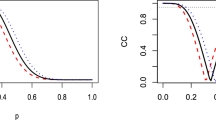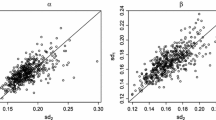Abstract
Let X be the number of successes in n mutually independent and identically distributed Bernoulli trials, each with probability of success p. For fixed n and \(\alpha \), there are \(n + 1\) distinct two-sided \(100(1 - \alpha )\)% confidence intervals for p associated with the outcomes \({X = 0, 1, 2, \ldots , n}\). There is no known exact non-randomized confidence interval for p. Existing approximate confidence interval procedures use a formula, which often requires numerical methods to implement, to calculate confidence interval bounds. The bounds associated with these confidence intervals correspond to discontinuities in the actual coverage function. The paper does not aim to provide a formula for the confidence interval bounds, but rather to select the confidence interval bounds that minimize the root mean square error of the actual coverage function for sample size n and significance level \(\alpha \) in the frequentist context.
















Similar content being viewed by others
References
Agresti A, Coull BA (1998) Approximate is better than ‘exact’ for interval estimation of binomial proportions. Am Stat 52:119–126
Anscombe FJ (1956) On estimating binomial response relations. Biometrika 43:461–464
Balch MS (2020) New two-sided confidence intervals for binomial inference derived using Walley’s imprecise posterior likelihood as a test statistic. Int J Approx Reason 123:77–98
Blaker H (2000) Confidence curves and improved exact confidence intervals for discrete distributions. Can J Stat 28:783–798
Brown LD, Cai TT, DasGupta A (2001) Interval estimation for a binomial proportion. Stat Sci 16:101–117
Clopper CJ, Pearson ES (1934) The use of confidence or fiducial limits illustrated in the case of the binomial. Biometrika 26:404–413
Deng LH, Deng EY, Shapiro LW (2009) The Riordan group and symmetric lattice paths. arXiv preprint. arXiv:0906.1844
Efron B, Tibshirani RJ (1993) An Introduction to the Bootstrap. CRC Press, Boca Raton
Kása Z (2009) Generating and ranking of Dyck words. Acta Universitatis Sapientiae Informatica 1:109–118
Kim J, Jang W (2021) A generalized Agresti–Coull type confidence interval for a binomial proportion. J Korean Stat Soc. https://doi.org/10.1007/s42952-021-00143-3
Lyles RH, Weiss P, Waller LA (2020) Calibrated Bayesian credible intervals for binomial proportions. J Stat Comput Simul 90:75–89
Meeker WQ, Hahn GJ, Escobar LA (2017) Statistical intervals: a guide for practitioners and researchers, 2nd edn. Wiley, Hoboken
Park H, Leemis LM (2019) Ensemble confidence intervals for binomial proportions. Stat Med 38:3460–3475
Wilcox R (2020) A note on inferences about the probability of success. J Mod Appl Stat Methods 18(1), Article 30. https://doi.org/10.22237/jmasm/1556670420
Wilson EB (1927) Probable inference, the law of succession, and statistical inference. J Am Stat Assoc 22:209–212
Yaacoub T, Goldsman D, Mei Y, Moustakides GV (2019) Tandem-width sequential confidence intervals for a Bernoulli proportion. Seq Anal 38:163–183
Acknowledgements
The authors thank Hayeon Park, Chris Weld, two anonymous reviewers, and the editor for their helpful comments concerning this paper.
Author information
Authors and Affiliations
Corresponding author
Additional information
Publisher's Note
Springer Nature remains neutral with regard to jurisdictional claims in published maps and institutional affiliations.
Appendix
Appendix
The structure of the algorithm for constructing the 100\((1 - \alpha )\)% RMSE-minimizing confidence interval is given below. The four existing confidence interval procedures used in the smoothing and the large-sample portions of the algorithm are the Wilson–score, Jeffreys, Arcsine, and Agresti–Coull.

This algorithm has been implemented in R in the binomTestMSE function in the conf package, which consists of about 700 lines of code. The numerical solution that minimizes the RMSE is performed by the uniroot.all function in R.
Rights and permissions
About this article
Cite this article
Feng, K., Leemis, L.M. & Sasinowska, H. RMSE-minimizing confidence intervals for the binomial parameter. Comput Stat 37, 1855–1885 (2022). https://doi.org/10.1007/s00180-021-01183-3
Received:
Accepted:
Published:
Issue Date:
DOI: https://doi.org/10.1007/s00180-021-01183-3




